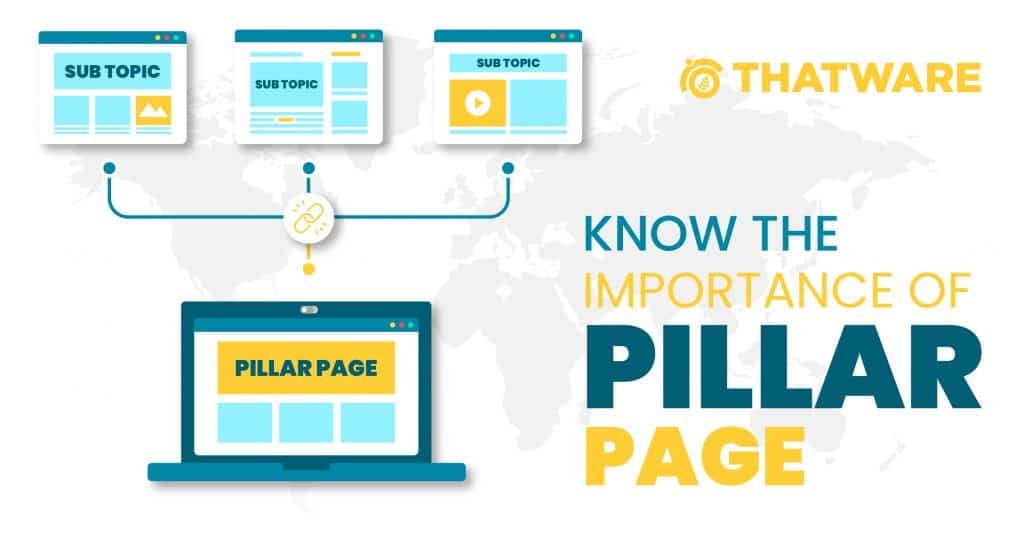SUPERCHARGE YOUR ONLINE VISIBILITY! CONTACT US AND LET’S ACHIEVE EXCELLENCE TOGETHER!
What is Pillar Page?
A pillar page is a page on your website that is the topical cornerstone for a large portion of your site’s content. Pillar pages generally are much longer than normal blog posts in the form of content. They’re often similar to an e-book with hyperlinked chapters at the top of the text. Thus pillar pages SEO will come into play for your campaign.
A pillar page serves as the backbone of your website’s content strategy, acting as a comprehensive resource that covers a broad topic in-depth. It serves as the topical cornerstone, around which related content, known as cluster content, revolves. Pillar pages are typically longer and more detailed than regular blog posts, resembling e-books or guides, and they often feature hyperlinked chapters for easy navigation.
In addition to its length and depth, a pillar page is characterized by its strategic organization and internal linking structure. It provides a holistic overview of a particular subject matter, offering valuable insights, information, and resources to your audience. By covering the core aspects of a topic comprehensively, pillar pages establish your website’s authority and expertise in that area, making it a go-to resource for both visitors and search engines.
One of the key purposes of a pillar page is to facilitate better organization and navigation of your website’s content. By structuring your content hierarchy around pillar pages and cluster content, you create a logical framework that guides visitors through their journey on your site. This organized approach not only enhances the user experience but also improves search engine visibility by signaling the relevance and depth of your content to search algorithms.

Why We Use in SEO?
It helps the organization of your content so that people can easily browse your website and consume your blog posts. Pillar pages SEO help to boost your site’s ranking as well.
Pillar pages are a key component of SEO strategy for several reasons:
- Organizing Content: Pillar pages serve as comprehensive guides or hubs that organize content around a central topic or theme. By structuring content hierarchically, with the pillar page covering broad topics and linked cluster content covering specific subtopics, you create a user-friendly navigation system that enhances user experience and makes it easier for search engines to understand the context of your content.
- SEO Structure: Pillar pages help to establish a clear structure for your website, which is beneficial for SEO. Search engines favor well-organized websites with logically structured content. By creating pillar pages that cover overarching topics and linking related cluster content to them, you signal to search engines the importance and relevance of your content, which can improve your website’s visibility and rankings in search results.
- Authority and Expertise: Pillar pages allow you to demonstrate your authority and expertise in a particular subject area. By providing comprehensive, in-depth content on a specific topic, you establish yourself as a trusted source of information in your industry. This can help to attract backlinks from other websites, which are an important ranking factor for search engines.
- Internal Linking: Pillar pages serve as central hubs for internal linking within your website. By strategically linking from the pillar page to related cluster content and vice versa, you create a network of interconnected pages that reinforce the topical relevance and authority of your content. This internal linking structure helps search engines discover and index your content more effectively, and can also improve user engagement by guiding visitors to relevant content.
- User Experience: Pillar pages contribute to a positive user experience by providing visitors with comprehensive, well-organized information on a particular topic. When users can easily find the information they’re looking for, they are more likely to stay on your website longer, engage with your content, and return in the future. Positive user engagement metrics, such as low bounce rates and high time on page, can indirectly benefit your SEO efforts by signaling to search engines that your website provides valuable and relevant content.
Pillar Pages Example
To get an overview of how a pillar page looks like, here’s an example provided here for your reference:
http://home.profitwell.com/saas-dna-project/hiten-shah-saas-marketing-product-strategy/
⭐️Things to Include :
- Concise introduction copy to establish credibility and topic discussion
- Clear cluster table of contents for quick reference
- Organized content clusters that support the pillar page topic
- Easily scannable content cluster headings and subheadings
- Lots of links to more in-depth website content
- Calls-to-action (optional)
⭐️How to Create
1: Choose a Topic
2: Find Subtopics Through Keyword Research
3: Write or Assign an Existing Page
4: Boost Your Page’s Authority Through Inbound Links
5: Stay on Top and Update Your Page Frequently
What Are Topic Clusters?
- Generally, topic clusters are groups of related content that collectively cover a broad subject area.
- Content clusters provide contextual support for other pages within a group. In addition, they also create a strong internal linking framework to help users (and search engines) find your content.
- It allows you to cover broad subjects and dominate keyword categories in organic search.
Topic clusters implementation is SEO can give your campaign a noticeable boost in terms of organic traffic. It enhances context, relevance and authority. Also, UX and conversions are on rising with the topic clusters.
Pillar Pages SEO Optimization – Successful Steps to Follow
Pillar pages are essential elements of a successful SEO strategy that can significantly improve the visibility and structure of a website. These pages serve as the central hub for a website’s content, helping to organize and structure information for both users and search engines. In this guide, we will delve deeper into how pillar pages can supercharge your online presence and improve your website’s SEO performance, covering new strategies, topic clusters, and key optimizations.
The Purpose of Pillar Pages in SEO
Pillar pages are essential in organizing a website’s content and improving SEO in multiple ways:
- Organizing Content: By grouping related topics together, pillar pages create a clear content hierarchy. This makes it easier for both users and search engines to navigate and understand the context of your site’s information.
- Enhancing SEO Structure: A pillar page helps search engines understand the relationships between different pieces of content on your website. This results in better indexing, improved rankings, and increased organic search visibility.
- Establishing Authority: By providing detailed, authoritative content on a topic, pillar pages demonstrate your expertise and increase your credibility. This can help you earn valuable backlinks from other high-authority websites.
- Internal Linking: Pillar pages serve as the central hub for internal linking. By linking to related content (cluster content), they reinforce the topic’s relevance and improve the overall SEO structure of your website.
- User Experience: Offering comprehensive, well-organized information improves the overall user experience. A positive experience, including longer page visits and lower bounce rates, signals to search engines that your website offers valuable content, which can enhance your rankings.
Why Are Pillar Pages Important for SEO?
Pillar pages play a crucial role in boosting your website’s SEO efforts. By organizing your content effectively, you can help search engines and users understand the context of your site, making it easier for both to navigate your information. Here’s why pillar pages are so important:
- Content Organization: A clear, structured approach to content improves site navigation, ensuring users can find relevant information easily. For search engines, a well-organized site is easier to crawl, index, and rank.
- Improved Rankings: Search engines prefer sites with organized, comprehensive content. Pillar pages signal to Google and other search engines that your content is highly relevant, improving your rankings and increasing visibility.
- Boosting Authority: By creating in-depth content on a broad topic, pillar pages help establish your authority within your niche. When other websites link to your pillar page, it enhances your site’s credibility and authority in the eyes of search engines.
- Enhanced Internal Linking: With pillar pages at the center of your content strategy, you can create a web of internal links that enhances the flow of link equity across your site, improving SEO performance.
- Better User Engagement: Offering comprehensive, well-structured information enhances user experience, which can reduce bounce rates and increase time spent on your site. Both of these factors can indirectly improve SEO rankings.
How to Create a Pillar Page
Creating a pillar page involves a few key steps that ensure it will effectively serve its SEO purpose. Follow these steps to create an optimized pillar page:
- Choose a Broad Topic: Your pillar page should cover a broad topic that is relevant to your business and has significant search volume. This topic will serve as the foundation for all related cluster content.
- Conduct Keyword Research: Use keyword research tools to identify related subtopics and keywords that will help you develop cluster content. These subtopics should be narrower and more specific, providing detailed information related to your pillar page.
- Develop Comprehensive Content: The content on your pillar page should be long-form, informative, and valuable to your audience. It should provide a high-level overview of the chosen topic, with links to related articles (cluster content) for users to explore more detailed information.
- Boost Authority with Inbound Links: Once your pillar page is live, work on building inbound links from other reputable websites to boost the authority of the page. This will also improve the page’s SEO performance.
- Regularly Update the Page: To keep the content relevant and up-to-date, periodically review and update your pillar page. Add new insights, statistics, and information as the topic evolves.
What Are Topic Clusters?
Topic clusters are groups of related content that revolve around a central pillar page. They provide more context and depth to the topic covered by the pillar page. Each piece of cluster content addresses a specific subtopic and links back to the pillar page, helping to reinforce the main topic’s relevance.
Implementing topic clusters is a highly effective SEO strategy. It allows you to target a broader range of keywords within the same subject area, helping to dominate keyword categories in search results. By creating a strong internal linking structure between your pillar page and cluster content, you signal to search engines the importance and relevance of each page.
How Topic Clusters Benefit SEO
Topic clusters provide several SEO benefits:
- Improved Content Context: By linking related content together, topic clusters create a web of interconnected pages that provide context for search engines. This helps search engines better understand the relevance of your content, improving rankings.
- Increased Organic Traffic: By covering a wide range of subtopics within a broader theme, topic clusters enable you to rank for multiple related keywords. This can increase organic traffic to your website.
- Stronger Internal Linking: Topic clusters help create a robust internal linking structure, which improves site navigation and ensures link equity is spread evenly across your site.
- Better User Experience: When users can easily navigate between related content, they are more likely to engage with your site and stay longer, which can reduce bounce rates and improve user engagement metrics.
- Enhanced Authority: By covering a broad topic and its subtopics comprehensively, you establish yourself as an authority in your field. This can help you earn backlinks and further boost your site’s credibility.
Examples of Effective Pillar Pages
Here are a few examples of successful pillar pages that have implemented the principles of topic clusters effectively:
- SaaS Marketing Strategy: A company that offers SaaS products might create a pillar page on “SaaS Marketing Strategy,” covering broad topics like customer acquisition, content marketing, and conversion optimization. Each of these subtopics would have its own dedicated page, linked back to the main pillar page.
- Travel Blog: A travel blog could create a pillar page about “Traveling in Europe,” which would cover topics like budget travel, must-see destinations, and travel safety. Each subtopic would link back to the main page, helping to establish the blog as a trusted resource for European travel.
Future Trends and Developments in Pillar Page Strategy
A. Evolving Role of Pillar Pages in SEO Landscape
1. Contextual Adaptation: As search engine algorithms continue to evolve, the role of pillar pages may adapt to prioritize contextual relevance over traditional keyword-centric optimization. This shift could emphasize the importance of creating comprehensive, authoritative content that addresses user intent and provides value beyond simple keyword targeting.
2. Semantic Search Integration: With the increasing sophistication of search engines in understanding natural language and semantic context, pillar pages may need to incorporate semantic markup and structured data to enhance their visibility and relevance in search results. This could involve leveraging schema.org markup and other structured data formats to provide search engines with additional context about the content and its relationship to related topics.
3. User Experience Focus: Future trends may see a greater emphasis on user experience optimization within pillar pages, including factors such as page speed, mobile-friendliness, and accessibility. Ensuring that pillar pages deliver a seamless and engaging user experience across devices and platforms could become essential for maintaining search engine visibility and driving organic traffic.
B. Emerging Technologies and Tools for Pillar Page Optimization
1. AI-Powered Content Generation: The use of artificial intelligence (AI) and natural language processing (NLP) technologies could revolutionize pillar page optimization by automating content generation, topic ideation, and optimization tasks. AI-powered tools may assist in analyzing user intent, identifying relevant topics, and generating high-quality content that aligns with search engine algorithms and user expectations.
2. Advanced Analytics Platforms: Emerging analytics platforms may offer enhanced capabilities for monitoring and optimizing pillar page performance, providing actionable insights into user engagement, content effectiveness, and search engine visibility. These platforms could leverage machine learning algorithms to identify trends, patterns, and opportunities for optimization, helping SEO professionals refine their pillar page strategies and drive better results.
3. Voice Search Optimization: As voice search continues to gain prominence, pillar page optimization may need to account for the unique characteristics and preferences of voice search users. This could involve optimizing content for natural language queries, structuring content to address common voice search intents, and leveraging schema markup to enhance visibility in voice search results.
C. Predictions for Future Trends in Content Organization and Optimization
1. Topic Clustering and Semantic Connectivity: Future trends may see a greater emphasis on topic clustering and semantic connectivity within pillar pages, with content organized around broader themes and interconnected through semantic relationships. This approach could improve content coherence, topical relevance, and search engine visibility by providing search engines with a deeper understanding of the relationships between different topics and subtopics.
2. Personalized Content Experiences: As personalization technologies continue to evolve, pillar pages may incorporate dynamic content elements and personalized recommendations based on user preferences, behavior, and demographics. This could involve leveraging user data and machine learning algorithms to deliver tailored content experiences that resonate with individual users and drive engagement and conversions.
3. Multi-Channel Integration: Future trends may see pillar pages integrated more seamlessly across multiple channels and platforms, including social media, email marketing, and voice assistants. This could involve repurposing pillar page content for different formats and channels, optimizing content distribution strategies, and leveraging cross-channel analytics to measure performance and ROI across touchpoints.
These future trends and developments in pillar page strategy underscore the dynamic and evolving nature of SEO and content optimization, highlighting the need for SEO professionals to stay informed and adapt their strategies to capitalize on emerging opportunities and technologies. By embracing these trends and leveraging innovative tools and techniques, businesses can enhance their pillar page strategies and maintain a competitive edge in the ever-changing digital landscape.
End note
From the perspective of ThatWare, a forward-thinking digital marketing agency focused on cutting-edge SEO strategies, the concept of pillar pages holds immense significance in the ever-evolving landscape of search engine optimization.
Pillar pages serve as the foundational cornerstone for organizing and structuring content around core topics, allowing ThatWare to showcase its expertise and authority in various industry verticals. By strategically implementing pillar page strategies, ThatWare can effectively boost its clients’ website rankings, enhance user experience, and drive organic traffic.
The insights provided in this comprehensive guide highlight the critical role of pillar pages in modern SEO strategies, emphasizing their ability to adapt to emerging trends such as semantic search integration, AI-powered content generation, and voice search optimization. As search engine algorithms continue to evolve, ThatWare recognizes the importance of staying ahead of the curve and embracing innovative technologies and tools to optimize pillar pages for maximum impact.
In conclusion, ThatWare reaffirms its commitment to implementing pillar page strategies as a cornerstone of its SEO efforts. By leveraging the insights and best practices outlined in this guide, ThatWare aims to empower its clients with robust pillar page strategies that drive tangible results, elevate their online presence, and ultimately, fuel business growth in the digital era.

Thatware | Founder & CEO
Tuhin is recognized across the globe for his vision to revolutionize digital transformation industry with the help of cutting-edge technology. He won bronze for India at the Stevie Awards USA as well as winning the India Business Awards, India Technology Award, Top 100 influential tech leaders from Analytics Insights, Clutch Global Front runner in digital marketing, founder of the fastest growing company in Asia by The CEO Magazine and is a TEDx speaker and BrightonSEO speaker.


